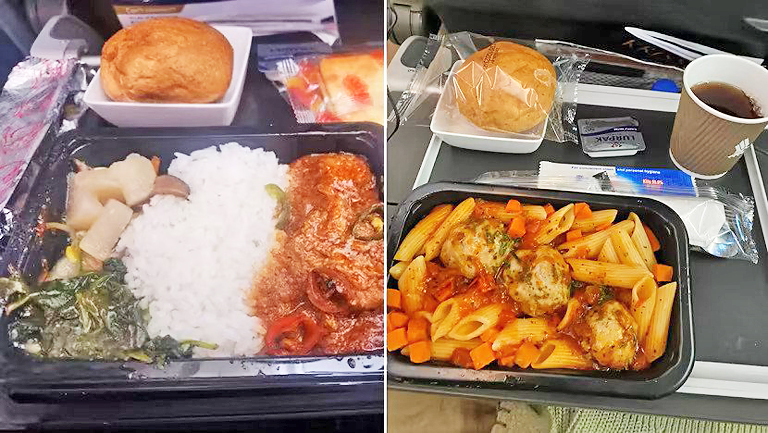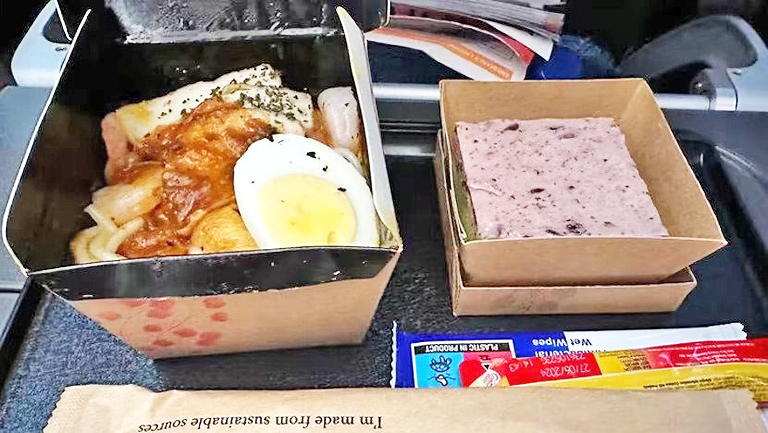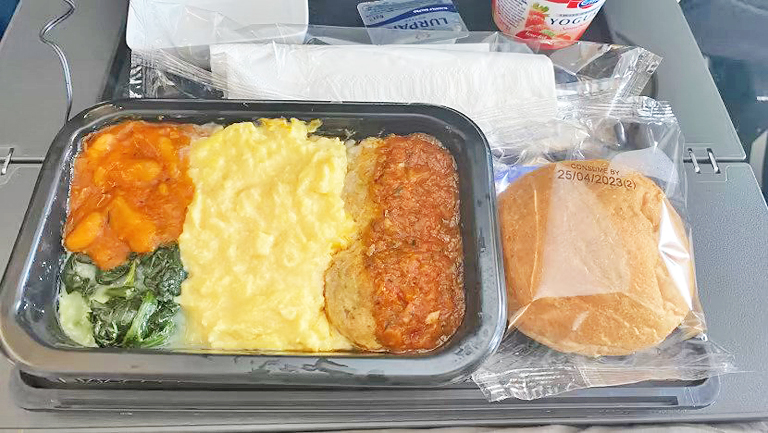CNA – Singapore Airlines (SIA) is bringing back some elements of its in-flight dining experience, such as appetisers for economy class meals. This comes after the airline got flak for the food it has been serving since travel picked up after the pandemic.
In recent months, some netizens have given the thumbs down to the national carrier for its economy class meals, with a paper serviceware trial in March igniting discussion around the airline’s food presentation. Then in April, a thread on online forum Reddit called into question the “downgraded” food quality in SIA’s economy class.
Amid heightened complaints, SIA reported a record annual profit of SGD2.16 billion (USD1.63 billion) earlier this month – which only seemed to fan the flames.
Social media reactions to the news highlighted the perceived disparity between the airline’s profit and food standards, with calls for “better quality meals with classier packaging” and “all the other pre-pandemic perks”.
APPETISERS TO RETURN FROM JUNE
An SIA spokesperson told CNA on Wednesday that the airline will bring back appetisers for economy class meals from June 1.
Appetisers will be served with all economy class meals on medium-, long-haul and ultra-long haul trips – essentially any flight that is three-and-a-half hours and above. This is in addition to a bread roll, a main course, cheese and crackers, and a dessert.



Short-haul flights between one-and-a-half and three-and-a-half hours will now have bread rolls and butter for economy class meals. These will be served together with a main course and dessert.
Some other items that were removed from the meal tray during the pandemic for operational and supply chain reasons, as well as to reduce food waste, will be restored. This includes cheese and crackers, and muffins for continental breakfasts.
In response to criticism that the perceived decline in food standards is due to cost-cutting measures, the airline said it has not reduced its budget.
The spokesperson said SIA’s current budget for in-flight meals is about 20 per cent higher than that for the 2019/2020 financial year, even though the airline expects that its capacity will be lower than that year.
Still, the crux of the criticism lies in unmet expectations, said frequent flyers of SIA.
‘WORLD CLASS’ BRANDING SETS CUSTOMER EXPECTATIONS
For a start, SIA’s premium branding is a double-edged sword, said Aaron Wong, founder of The Milelion, a Singapore-based online resource for travel miles and points.
“SIA has arguably made a rod for their own backs with the whole ‘Welcome to World Class’ campaign. Because people are always going to beat you with that stick,” the 35-year-old told CNA, referring to the airline’s global brand campaign rolled out in January.
“It’s always been a hallmark of SIA to offer something that is really a cut above everyone else – and they have been brilliant at that for a very long time. But the flip side is that once you cut back, people will notice.”
Food and travel blogger Laurence Foo, who has reviewed SIA’s food offerings, pointed out that under the “broader backdrop of shrinkflation and ever-rising costs”, the airline’s profits coupled with its food standards are “just something that is further stinging ordinary consumers”.
“The heart of the issue is that SIA commands a price premium over most airlines, and most people were happy to pay this as it was viewed that you got what you paid for – good service and value,” he said.
The 36-year-old, who flew at least twice a year with SIA pre-pandemic, noticed a “substantial decline” in offerings when travel resumed.
Echoing similar sentiments about unfulfilled expectations, Fairuz Sallim, who founded travel hacks blog Suitesmile, suggested that the “problem” may not actually be the food.
Instead, the airfare that passengers pay sets their expectations.
“Expectations are high when a customer is paying two to three times more than other airlines. It’s probably fair that they get disappointed when the high expectations are not met,” he said.
PRESENTATION, OPTICS ARE ‘EVERYTHING’
When passengers pay premium prices, mere presentation and plating begin to matter that much more.
The paper serviceware trial in March – which was rolled out in economy class and premium economy class on selected flights to “reduce the amount of single-use plastics on board the aircraft” – had some likening the containers to the outration meal boxes used by the Singapore Armed Forces.
SIA had rejected the suggestion that the new containers were part of cost-saving measures – and in fact, said the paper containers cost more than the current plastic casserole dish.
The airline told CNA that the trial was part of its efforts to offer more main course options, such as “Singaporean favourites and gravy-rich dishes such as laksa, mee siam and congee”.
“The design of the serviceware is also better at retaining heat and moisture than the casserole dish, helping to enhance the taste and quality of our main courses,” it added.
While the trial was met with criticism and confusion on social media, it wasn’t the first time SIA had rolled out sustainable serviceware. Economy class “boxed meals” were introduced in the midst of the pandemic in December 2020, and are now standard on short-haul flights.
In an Instagram Story call-out by CNA asking for travellers’ experiences, some sent in photos, with one user calling it “lousy packaging”. The woman, who wanted to be known as Siew, told CNA that placing “laksa into the container… will (cause it to) spill easily”.
The Milelion’s Wong, who takes SIA flights at least twice a month noted that the problem was the “one size fits all” container is used as the standard meal box on these flights.
“You try and put a full English breakfast inside there. It was never made for that. Things will get soggy, things will stack up… Because you have to use it for everything, some of the stuff looks really unappetising,” he said, adding that the box “just doesn’t work with certain types of cuisines”.
Reiterating the expectations of SIA passengers, Wong added that those who pay for an SIA ticket “don’t generally expect to see something that they associate with takeaway food”.
“This is probably an issue where optics is everything,” he said.
FOOD ‘SIGNIFICANT EXPENSE’ FOR AIRLINES
While complaints about airline food are nothing new, frustrated SIA passengers have become “a lot more vocal”, Wong observed.
He cited the removal of several items over time – hot towels, the appetiser and fruits course in an economy class meal, and even paper menus that economy class passengers used to receive – that “chipped away around the edges”.
Many criticisms tend to categorise all perceived declining standards as “cost cutting” – but it’s not that straightforward.
As much as some criticisms are valid, “we need to be very, very clear” that there are “misconceptions going around”, he added.
Even as SIA has said they have not been cutting costs for in-flight meals, Wong acknowledged that food expenditure can impact an airline’s overall costs.
Airlines “operate at such a volume, that even a very small change, like removing one piece of chicken, can have a huge effect”, simply due to the number of portions served, he said.
He highlighted the famous story of how American Airlines discovered in the 1980s that removing one olive from every passenger’s salad would reduce its costs by USD40,000. It demonstrated the impact of a seemingly insignificant item on a carrier’s bottom line.
An aviation expert who spoke to CNA also agreed that food can indeed be a “significant expense” for airlines, “not to mention the crew resources tied up in storing, preparing, serving and clearing meals”.
Asia managing editor for industry publication FlightGlobal Greg Waldron said cost-savings are why budget carriers only serve food on demand.
Nonetheless, SIA passengers on medium- and long-haul flights have been served a bigger portion of food since the current disposable plastic casserole dish was introduced in April 2020.
“(It is) larger than the one that we used pre-pandemic. This has allowed us to serve our customers heartier and larger main course portions, up to 30 per cent more by weight. This again is in response to customer feedback requesting larger main course portions,” the company said.
Some netizens have also taken a more measured stance against critics.
“If the (sustainable) packaging is more expensive and the company is doing it because of the environment… I would rather go with the new packaging,” said one Facebook commenter.
Another highlighted the “not bad” mee siam and said “people shouldn’t have too high expectations” for economy class.







